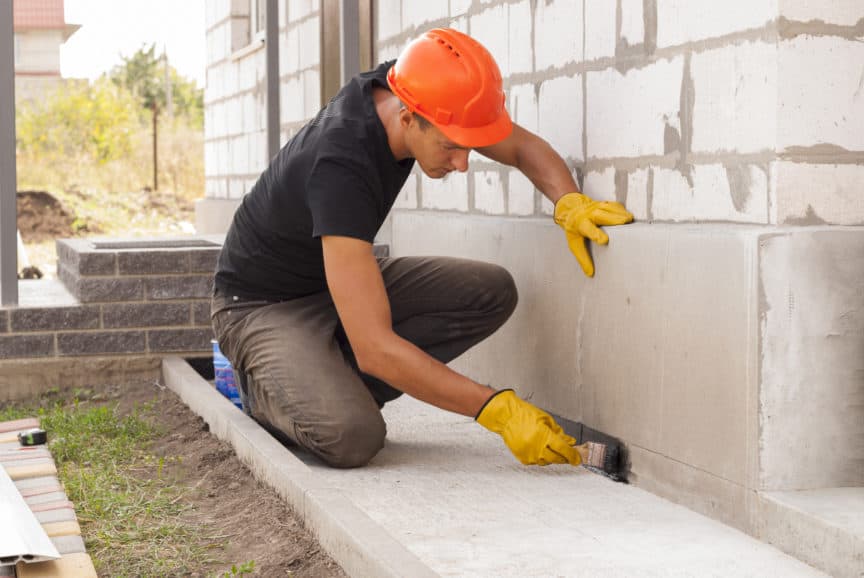
Damp proofing refers to the protective layer that is placed between the property’s exterior ground and it. DPC is the name that indicates its function, independent of the materials used to make a dampproof course.
Dampness and Damp Proofing
Here are the main reasons dampness can occur in buildings
Rain penetration
Site level
Climate conditions
Poor orientation of the building
Construction joints in the structure
Construction materials of low quality
Soil drainage problems
Entrapped moisture during concreting
Use of low-quality concrete
Moisture ingress is from the ground to walls
Rain falling from the walls
Rain on the building’s exterior walls
Condensation problems

Below are some causes of dampness.
Moisture ingress is from the ground to the walls
If the soil upon which the foundation rests is porous, then moisture can travel through the structure. Capillary action also allows the previous soil to absorb moisture. This moisture then rises from the floors into the walls of buildings. This is a slow process, but the results are evident as soon moisture reaches the walls.
Rain can travel from the walls of this building
If the walls and roofs are not waterproof, water can travel down the walls and cause dampness.
Rain on the exterior walls
The dampness that enters buildings from rainwater collecting on the balcony can lead to damage to paints and other interior decorations. The dampness can be prevented by properly treating the exterior walls of buildings.
Condensation Damp Proofing
Condensation can be caused by dampness in the building. This is due to changes in temperature inside and outside the building. Water gets deposited onto roofs, ceilings and walls.
You may have other factors that could cause moisture to enter the building.
Drainage issues at the site
Water accumulation can occur if the roof slope is not perfect.
Poor construction techniques can lead to roof joints and other defects.
It is possible for water to remain in the building for a longer time if the orientation of the building is not such that it allows less sunlight into the building.
Building Dampness:
These are the effects of dampness on buildings:
Ingress of moisture from buildings’ ceilings and walls can result in cracks or crumbling of plaster or paint.
Dampness in a building can lead to termites or mosquito breeding.
When woodwork comes in contact with damp walls or floors, it can cause warping, buckling and deformation. Doors, windows and wardrobes, for example, may become warped.
Excessive moisture can cause efflorescence, which can show up on bricks and stone stiles. All of these factors eventually lead to wall strength loss.
Short circuits are more dangerous than ever because of electricity leakage from electrical fittings that have moisture or dampness.
Metal fittings attached to walls, roofs, and ceilings can corrode and trust dye to moisture.
Due to dampness, the plaster of the building can soften or crack, especially in lime plaster.
Dampness can cause wall decorations to fall apart, such as paintings and puttings.
The ground tiles may cause cracks in the floors and weaken their integration with the floor.
The moisture in the structure may lead to termites growing and increasing in number.
People with asthma can be affected by a damp and mildew atmosphere in their home. It is best to dampproof your house and remove any excess moisture. DPC dampproofing has been the best method of dampproofing homes since 1970. More than a million homes have benefitted from this damp proofing technique.
Rising Damp your home has many benefits
Here are some benefits to dampproofing your home:
Dampproofing your home is an effective way to keep it in good working order. The DPC system can help you keep your homes in top shape.
Damp proofing is also a good option to get rid of bacteria and mildew. These triggers are very important for those suffering from asthma and bronchitis. Dampproofing ensures your family remains safe and healthy.
Chemical damp proofing injections are the same as South Africa’s damp proofing. They will prevent moisture seepage into the walls and also remove any remaining moisture.
Damp proofing your home will ensure that plaster and paint lasts longer.
How to damp proof your home
The following steps are required to dampproof your home.
The old plaster has been striped and holes drilled at each base of your homes.
After that, a chemical-filled injection is inserted into the holes. The chemical is then injected to ensure complete absorption.
The plaster is then used to seal the holes.
Once dry, another plaster is applied to the walls.
After drying, the walls can then be repainted to their original colors.